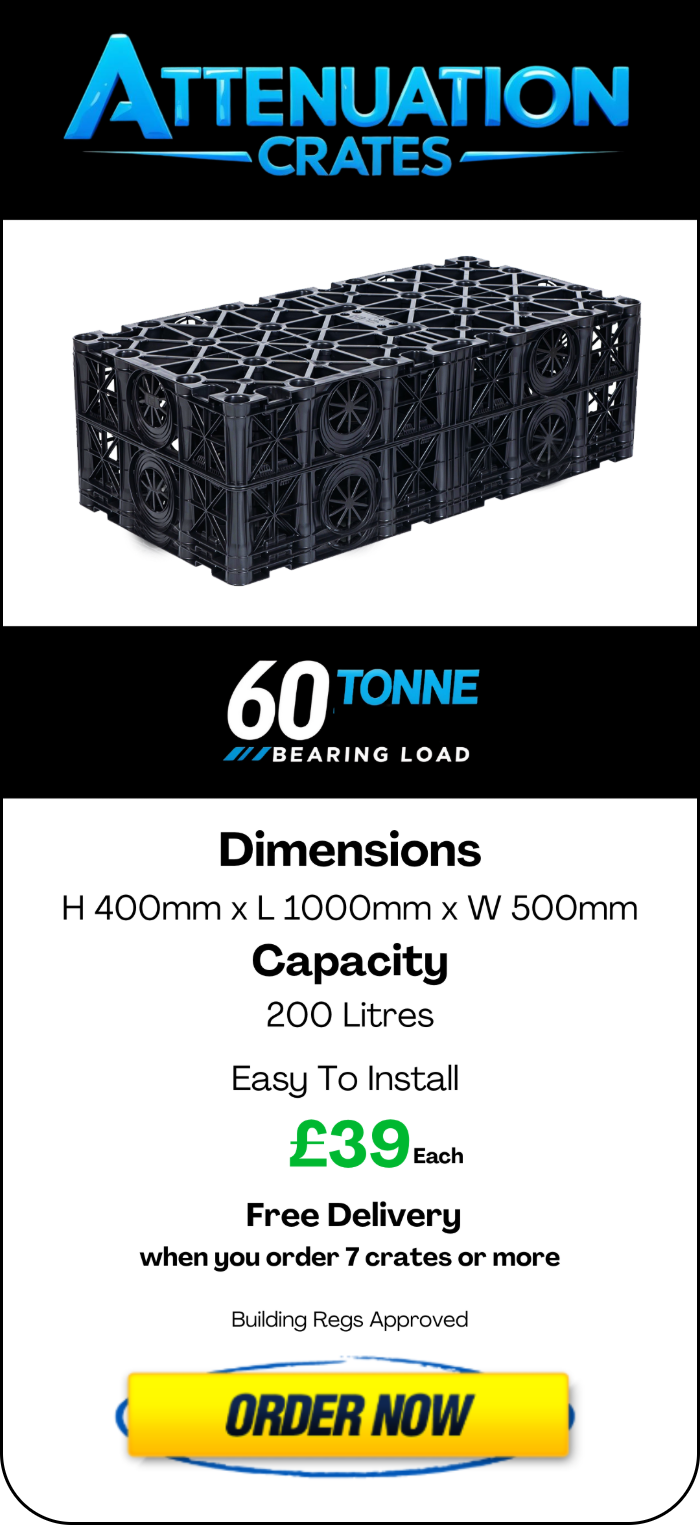

SuDS: Your Complete Guide to Sustainable Drainage Systems and Attenuation Crates and Attenuation Tanks in the UK
Flooded streets, overwhelmed sewers, and soggy gardens—sound familiar? For example, Sustainable Drainage Systems (SuDS) offer a smarter way to manage rainwater in the UK. Unlike old-school drainage that rushes water straight to rivers, SuDS mimic nature, slowing it down, soaking it up, and cleaning it along the way. Therefore, they’re a game-changer for builders, schools, and homeowners tackling floods and pollution. At Builders Yard, we’re all about practical solutions—think attenuation crates or soakaways—that fit right into SuDS designs. Ready to ditch the deluge? Let’s explore how SuDS work, why they matter, and how you can use them. Meanwhile, check out CIRIA’s SuDS resources for expert insights.
Quick Navigation:
– What Is SuDS?
– Benefits of SuDS
– How SuDS Works
– SuDS Techniques
– UK Regulations and Compliance
– Maintenance and Longevity
– FAQs
– Our SuDS Solutions
What Are Sustainable Drainage Systems (SuDS)?
Sustainable Drainage Systems—or SuDS for short—are all about managing water the natural way. For instance, instead of concrete pipes shunting rain to the nearest river, SuDS use features like ponds, swales, and permeable pavements to slow, store, and filter runoff. Born from the need to tackle urban flooding and pollution, they’ve been a UK focus since the 1990s. As a result, they’re now a cornerstone of eco-friendly construction, backed by groups like the Environment Agency.
Purpose and Goals of SuDS
Why bother with SuDS? Because they hit four big targets: reducing flood risk, improving water quality, boosting biodiversity, and creating nicer places to live. For example, a grassy swale doesn’t just hold water—it cleans it and gives bugs a home. Learn more from DEFRA’s technical standards.
Benefits of Sustainable Drainage Systems
SuDS aren’t just a regulatory box to tick—they’re packed with perks. Here’s why they’re worth it:
– Flood Prevention: By slowing runoff, SuDS cut the risk of overwhelmed drains. Perfect for rainy UK towns.
– Water Quality: Filters in SuDS strip out pollutants like oil or grit before water hits rivers.
– Wildlife Boost: Ponds and wetlands attract birds, bees, and more.
– Cost Savings: Less pipework means lower build costs over time.
Furthermore, schools love them—check out this guide on SuDS for eco-friendly campuses.
How Sustainable Drainage Systems Work
Think of SuDS as nature’s drainage crew. For instance, rain hits a car park, but instead of pooling, it seeps through permeable paving into a storage layer below. Meanwhile, a swale—a shallow, grassy ditch—catches runoff from a road, slowing it down and filtering it. As a result, water either soaks into the ground or trickles away cleanly. Therefore, it’s less about pipes and more about working with the landscape.
Hydraulic Magic in SuDS
Hydraulics matter here. SuDS control flow rates—say, keeping runoff to 5 liters per second per hectare—to avoid downstream floods. Read the Environment Agency’s 2005 report for the techy details.
SuDS Techniques: Sustainable Drainage Options
SuDS come in many flavors, each with a job to do. However, here are the big hitters:
Permeable Paving
Imagine a car park that drinks rain. Permeable paving lets water sip through to a storage layer, cutting runoff fast.
Swales and Basins
Swales are grassy channels; basins are shallow dips. Both hold water temporarily, letting it soak in or evaporate.
Ponds and Wetlands
These beauties store water long-term, clean it, and look good doing it. Great for biodiversity too.
Attenuation Features
For example, attenuation crates—like the ones we sell at Builders Yard—store water underground, releasing it slowly. Perfect for tight urban spaces.
SuDS UK Regulations and Compliance
In the UK, SuDS aren’t optional—they’re law in many cases. For instance, the Flood and Water Management Act 2010 pushed for sustainable drainage in new builds. Meanwhile, Schedule 3 (due to roll out soon) will make SuDS mandatory for most developments over 100 square meters. As a result, builders need to know the SuDS Technical Standards—think flow rates, volume control, and pollution checks.
Why SuDS Compliance Matters
Non-compliance? Fines or delays. However, get it right, and you’re golden—councils love SuDS that meet British Standards.
Maintenance and Longevity of Sustainable Drainage Systems
SuDS aren’t set-and-forget. For example, a clogged swale won’t work, so regular checks are key. Here’s how to keep them humming:
Cleaning Tips
Clear debris from swales monthly. Inspect permeable paving for silt buildup yearly—jet wash if needed.
Longevity
Done right, SuDS last decades. For instance, well-maintained ponds can thrive for 50+ years, per the Environment Agency’s 2012 report.
Frequently Asked Questions About SuDS
Got questions? Because we’ve got answers, here’s what folks often ask:
Q: What’s the point of SuDS?
A: To cut floods, clean water, and boost nature—simple as that.
Q: Are SuDS mandatory in the UK?
A: Soon, yes—Schedule 3 is coming. Check our SuDS solutions page.
Q: How much do SuDS cost?
A: Varies—permeable paving might run £50-£100 per square meter. Affordable options like crates start at Builders Yard.
Q: Can I install SuDS myself?
A: Small stuff, sure. Bigger systems need pros—see our team.
Our Sustainable Drainage Solutions at Builders Yard
Ready to jump into SuDS? For instance, we’ve got you covered:
– Attenuation Crates: Store water underground, from £50 per unit.
– Permeable Paving Kits: DIY-friendly, starting at £80 per square meter.
– Swale Liners: Durable and cheap, from £20.
Shop Now – Free UK delivery on orders over £100.
Why Sustainable Drainage Systems Are the Future
I’ve seen my fair share of flooded sites—trust me, traditional drainage isn’t cutting it anymore. SuDS are different. For example, they tackle climate change head-on, soaking up heavier rains and keeping rivers cleaner. Meanwhile, they save cash long-term and make spaces people love. Therefore, whether you’re a builder in Leeds or a school in Cornwall, SuDS—like our attenuation crates—are your ticket to smarter drainage. As a result, grab what you need from our store and join the sustainable revolution. For more, see DEFRA’s SuDS guide.
SuDS Technical Guide: Hydraulic, Structural, and Water Quality Insights for UK Drainage
Designing drainage that stands up to UK storms isn’t just about digging ditches—it’s a science. For instance, Sustainable Drainage Systems (SuDS) blend hydraulics, structural engineering, and water chemistry to manage runoff smarter. Unlike traditional systems that shunt water away fast, SuDS prioritize flow control, pollutant removal, and ecological balance. Therefore, if you’re a developer or engineer, understanding the technical nuts and bolts—say, peak flow rates or sediment filtration—is key. At Builders Yard, we supply tools like attenuation crates to make it happen. Ready to geek out on SuDS? Let’s unpack the science behind sustainable drainage. Meanwhile, dive into CIRIA’s SuDS Manual for cutting-edge guidance.
Quick Navigation:
– SuDS Hydraulics
– Water Quality Treatment
– Structural Design
– Ecological Impacts
– UK Technical Standards
– Implementation Challenges
– FAQs
– Our SuDS Tools
SuDS Hydraulics: Controlling Flow with Precision
Hydraulics in SuDS is about taming water’s speed and volume. For example, urban runoff can hit 100 liters per second per hectare during a storm, overwhelming sewers. SuDS, however, cap flows—often to 2-5 l/s/ha for a 1-in-100-year event, per the Environment Agency’s 2005 report. As a result, features like filter drains or detention basins act as hydraulic brakes, spreading water release over hours or days.
Flow Attenuation
Attenuation is the star here. For instance, a filter drain with a 300mm gravel bed can reduce peak flows by 60%, storing water temporarily. Meanwhile, the Manning’s equation (Q = (A/P)^(2/3) * S^(1/2) * n^(-1)) helps engineers calculate flow resistance in swales. Curious? The 2005 report dives deeper.
Water Quality Treatment in Sustainable Drainage Systems
Runoff isn’t just water—it’s a cocktail of pollutants. For example, urban roads carry hydrocarbons, heavy metals like zinc (up to 0.5 mg/L), and suspended solids (200-500 mg/L). SuDS tackle this through physical, chemical, and biological processes. Consequently, a wetland can remove 80% of total suspended solids (TSS) via sedimentation, per CIRIA’s findings.
Pollutant Removal Mechanisms
Filtration is key—think reed beds trapping grit. Meanwhile, adsorption binds metals to soil particles, and biodegradation by microbes breaks down oils. For instance, a 1m-deep filter drain can cut copper levels by 50%. Therefore, SuDS don’t just move water—they clean it. See this 2012 study for data.
Structural Design of SuDS Components
SuDS features must withstand physical stress—think traffic loads or soil pressure. For example, permeable pavements need a sub-base (e.g., 200mm Type 1 aggregate) to handle 40-tonne lorries. As a result, structural design balances porosity with strength, ensuring a 20-year lifespan without cracking.
Load-Bearing Capacity
Take attenuation crates, like those at Builders Yard. They’re rated for 400 kN/m², perfect under car parks. Meanwhile, CIRIA’s C680 guide stresses geotextile liners to prevent soil ingress, boosting durability. Thus, good design means less maintenance.
Ecological Impacts of Sustainable Drainage
SuDS aren’t just pipes—they’re habitats. For instance, a wetland can host 50+ plant species, from reeds to rushes, supporting amphibians and birds. However, poor design risks ecological harm—say, sediment clogging fish spawning grounds. Therefore, the 2005 report flags balancing water retention with flow to protect downstream ecosystems.
Biodiversity Metrics
Studies show SuDS ponds increase invertebrate diversity by 30% over traditional drains. As a result, engineers use metrics like the Shannon Index to measure impact. For example, check DEFRA’s SuDS overview for eco-design tips.
UK Technical Standards for SuDS
UK SuDS must meet strict rules. For instance, DEFRA’s 2015 Non-Statutory Technical Standards demand runoff rates match greenfield levels—often 2 l/s/ha for small sites. Meanwhile, water quality treatment requires removing 70% of TSS for high-risk areas like industrial estates. As a result, engineers lean on software like MicroDrainage to model compliance.
Regulatory Nuances
Schedule 3 (Flood and Water Management Act 2010) will soon enforce SuDS for developments over 100m². Therefore, designs must pass local authority checks—think hydraulic calculations and pollution risk assessments. The 2015 standards spell it out.
Implementation Challenges for SuDS Solutions
Building SuDS isn’t all smooth sailing. For example, clay soils (common in the UK) slow infiltration, risking ponding. Meanwhile, urban sites lack space for big ponds. However, solutions exist—think hybrid systems pairing crates with filter drains. As a result, CIRIA’s 2005 hydraulic study suggests modular designs for tight plots.
Overcoming Barriers
Cost is another hurdle—SuDS can hit £500/m² for complex setups. For instance, using recycled plastic crates cuts expenses by 20%. Therefore, smart material choices make SuDS viable. Need help? Contact our team.
Frequently Asked Questions About SuDS Technical Design
Got queries? Because we’ve got answers, here’s what engineers ask:
Q: How do I calculate SuDS flow rates?
A: Use the Greenfield runoff formula—often 2 l/s/ha for 1-in-1-year storms.
Q: What’s the best SuDS for clay soils?
A: Attenuation crates or lined basins—see our SuDS range.
Q: How much TSS removal is needed?
A: 70% for high-risk sites, per DEFRA’s standards.
Q: Are SuDS designs software-modeled?
A: Yes—tools like MicroDrainage are standard.
Our Sustainable Drainage Tools at Builders Yard
Ready to build SuDS right? For instance, we stock:
– Attenuation Crates: 400 kN/m² strength, from £50.
– Geotextile Membranes: For filter drains, £15/m².
– Permeable Sub-Base: Type 3 aggregate, £30/tonne.
Shop Now – Free UK delivery over £100.
Why SuDS Science Matters
I’ve walked sites where runoff wrecked roads—bad drainage is no joke. SuDS, though, get it right. For example, their hydraulic precision cuts flood peaks, their chemistry cleans water, and their designs last decades. Meanwhile, they’re not just tech—they’re a nod to nature, boosting ecosystems while meeting UK laws. Therefore, whether you’re modeling flows in Bristol or speccing crates in Glasgow, SuDS are the future. As a result, grab your gear from Builders Yard and build drainage that works. For more, see Susdrain’s technical hub.

